army uniform setup guide
This guide provides essential information on setting up Army uniforms correctly, covering regulations, components, and proper wear. Updated for 2025, it ensures soldiers meet current standards effectively.
Importance of Proper Uniform Setup
Proper uniform setup is crucial for maintaining discipline, professionalism, and unit cohesion. It reflects a soldier’s pride and adherence to military standards. Correctly worn uniforms ensure safety, functionality, and identity in operational settings. The 2025 updates emphasize strict grooming and uniform policies, impacting both battlefield effectiveness and everyday duties. A well-set-up uniform fosters a sharp, professional image, essential for military operations and ceremonies. Adhering to these guidelines ensures soldiers present themselves respectfully and responsibly, upholding the Army’s traditions and values. Proper setup also aids in clear identification and rank recognition, vital for command structure and communication.
Overview of Army Uniform Regulations
Army uniform regulations are detailed guidelines ensuring consistency and professionalism across all ranks. Updated in 2025, these rules emphasize proper grooming, uniform wear, and insignia placement. They apply to all uniforms, including ASU, AGSU, OCP, and ACU. Regulations balance form and function, ensuring uniforms are both practical and respectful of tradition. They also address accessories, badges, and special occasion wear. Adherence to these standards is mandatory, reflecting discipline and unity within the Army. The 2025 updates clarify previous policies, providing clear instructions for soldiers to follow. Proper uniform setup is a key aspect of military identity and readiness.
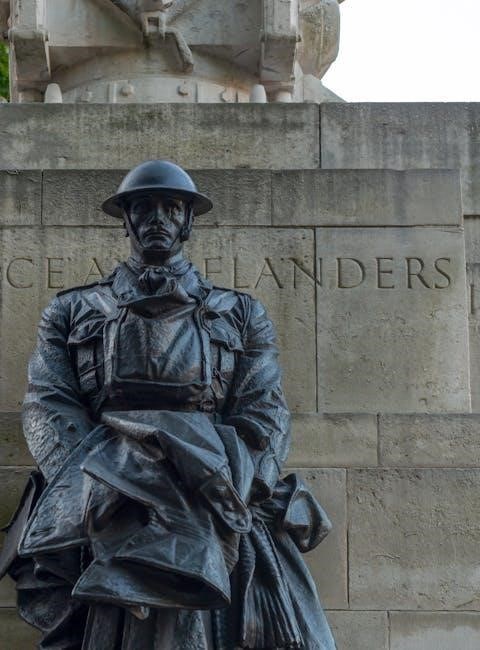
Types of Army Uniforms
The U.S. Army has four primary uniforms: Army Service Uniform (ASU) for formal events, Army Green Service Uniform (AGSU) for everyday wear, Operational Camouflage Pattern (OCP) for field operations, and Army Combat Uniform (ACU) for combat situations. Each serves a specific purpose, ensuring soldiers are appropriately dressed for various duties and occasions.
Army Service Uniform (ASU)
The Army Service Uniform (ASU) is a formal uniform worn for ceremonies, official events, and other special occasions. It consists of the Army Blue 450 Coat and 451 Trousers, paired with the Army White 521 Long or Short Sleeve Shirt and a necktie. The ASU is designed to project professionalism and discipline, with precise grooming and accessory standards. Proper setup includes correct placement of insignia, badges, and ribbons, ensuring a sharp, polished appearance. Adherence to regulations is crucial for maintaining uniformity and respect for tradition.
Army Green Service Uniform (AGSU)
The Army Green Service Uniform (AGSU) is a modern, professional uniform introduced in 2025, designed for everyday wear. It features a jacket and trousers in a distinctive green color, paired with a light-blue shirt and tie. The AGSU replaces older service uniforms, offering a sharp, cohesive look. Proper wear includes specific guidelines for headgear, belts, and accessories. Updates to regulations ensure clarity on acceptable configurations, emphasizing neatness and adherence to standards. This uniform reflects the Army’s commitment to tradition and modernization, ensuring soldiers present a polished appearance at all times.
Operational Camouflage Pattern (OCP) Uniform
The Operational Camouflage Pattern (OCP) Uniform is a versatile, combat-ready design introduced in 2019. It features a jacket and trousers with the OCP print, designed for blending into various environments. The uniform includes a moisture-wicking T-shirt for comfort and is paired with specific headgear and footwear. Updates to regulations ensure proper wear, emphasizing functionality and camouflage effectiveness. Soldiers are encouraged to use tools like the “Wear It Right Army Uniform Tool” for guidance. The OCP is essential for operational scenarios, balancing practicality and adherence to military standards.
Army Combat Uniform (ACU)
The Army Combat Uniform (ACU) is a functional and durable design for field operations. It includes a jacket and trousers with built-in knee pads, a moisture-wicking T-shirt, and compatible headgear and footwear. The ACU is designed for comfort and mobility in combat scenarios. Recent updates ensure adherence to current regulations, with tools like the “Wear It Right Army Uniform Tool” aiding soldiers in proper setup. The ACU remains a cornerstone of military attire, balancing practicality and performance for active-duty personnel.

Components of the Army Service Uniform (ASU)
The ASU includes a coat, trousers, shirt, tie, and accessories. The coat and trousers are Army Blue 450 and 451, paired with a white shirt and necktie for a polished look.
Coat and Trousers
The ASU coat is Army Blue 450, made from high-quality wool, and features a fitted design with button-front closure. Trousers are Army Blue 451, matching the coat’s fabric and color. Both are tailored for a sharp, professional appearance. The coat includes two waist pockets, while trousers have a stripe of braid for officers. Proper fit is crucial, with the coat reaching the hip and trousers breaking slightly above the shoes. These components are worn during formal events and ceremonies, embodying military tradition and discipline.
Shirt and Tie
The Army Service Uniform (ASU) shirt is Army White 521, available in long or short sleeves. It features a stiffened collar and button-front closure. The tie is black, made of silk or polyester, and must be snug against the shirt. Properly tying the necktie is essential, with the tip reaching the belt buckle. The shirt and tie combination ensures a polished, professional appearance, adhering to military standards. Attention to detail in fit and alignment is critical for a sharp, uniform look. This ensemble is worn for formal and ceremonial occasions.
Footwear and Accessories
Footwear for the Army Service Uniform (ASU) includes black leather oxfords, polished to a high shine. Accessories like belts, socks, and gloves must meet specific standards. The belt is black leather with a silver or gold buckle, depending on the uniform. Socks are plain black or dark-colored, and gloves are optional but must be black leather. These elements complete the uniform, ensuring a cohesive and professional appearance. Proper footwear and accessories are vital for maintaining military standards and projecting discipline. Attention to detail ensures a sharp, uniform look.

Components of the Army Green Service Uniform (AGSU)
The AGSU includes a jacket, trousers, and a long-sleeve shirt. It also features a necktie, belt, and headgear. These components create a professional, modern appearance.
Jacket and Trousers
The AGSU jacket and trousers are crafted from high-quality, durable fabric, ensuring a sharp, professional appearance. The jacket features a fitted design with button closures and side pockets, while the trousers have a streamlined fit with a zippered fly. Both components are made in the iconic Army green color, symbolizing tradition and service. The fabric is breathable and moisture-wicking, designed for comfort during extended wear. Proper fit is emphasized, with alterations allowed to ensure precision. These elements combine to create a uniform that honors heritage while meeting modern needs.
The Army Service Uniform (ASU) features an Army White 521 Long or Short Sleeve Shirt, paired with a black necktie. The shirt is made of high-quality cotton or a cotton-poly blend, ensuring durability and comfort. The tie must be properly knotted and centered, aligning with the top button of the shirt. This combination creates a polished, professional look, essential for formal occasions. Proper fit and alignment are crucial, as they contribute to the overall sharp appearance of the uniform. Adhering to these guidelines ensures consistency across all soldiers.
Headgear and Belt
Headgear and belts are essential components of the Army uniform, ensuring a professional appearance. The patrol cap is standard for operational uniforms, while the beret is reserved for special units. Belts must be worn with the uniform, with the Army Green Service Uniform (AGSU) requiring a matching belt made of genuine leather. Proper wear includes ensuring the cap is level and the belt is securely fastened. These elements contribute to a sharp, cohesive look, aligning with Army grooming and uniform standards. Attention to detail ensures compliance with regulations and maintains military decorum.
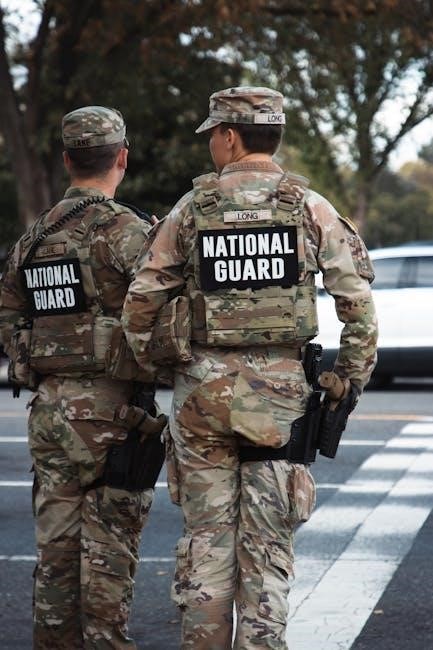
Components of the Operational Camouflage Pattern (OCP) Uniform
The OCP uniform includes a jacket, trousers, moisture-wicking T-shirt, and headgear. Footwear must match regulations, ensuring functionality and camouflage effectiveness in operational environments since October 1, 2019.
The OCP uniform features a jacket and trousers made from durable, moisture-wicking fabric. The jacket includes integrated shoulder pockets and a zippered chest pocket for storage. Trousers have built-in knee pads and cargo pockets for functionality. Both pieces are designed for comfort and mobility in operational settings. Proper fit is essential, with alterations allowed to ensure a sharp appearance. The OCP pattern blends into various environments, enhancing camouflage effectiveness. Soldiers must ensure the uniform is clean, pressed, and worn correctly to maintain military standards and professionalism.
Moisture-Wicking T-Shirt
The moisture-wicking T-shirt is a mandatory component of the OCP and ACU uniforms, designed for comfort in hot or high-intensity environments. Made from breathable, moisture-wicking fabric, it keeps soldiers dry by pulling sweat away from the skin. The T-shirt is snug-fitting to maintain a professional appearance and ensure proper layering under the uniform jacket. It is available in two colors: sand and coyote brown, with the sand color primarily used for OCP. Proper fit is essential to meet uniform standards and maintain functionality during missions.
Headgear and Footwear
Headgear and footwear are critical components of Army uniforms, ensuring both functionality and adherence to regulations. The Patrol Cap is standard for OCP and ACU, while the AGSU features a garrison cap. Footwear varies by uniform: Coyote Brown boots for OCP and black oxfords for AGSU. Proper fit and polish are mandatory to maintain a professional appearance. These items must align with specific guidelines to ensure uniformity and readiness, reflecting the Army’s emphasis on discipline and practicality in every detail.
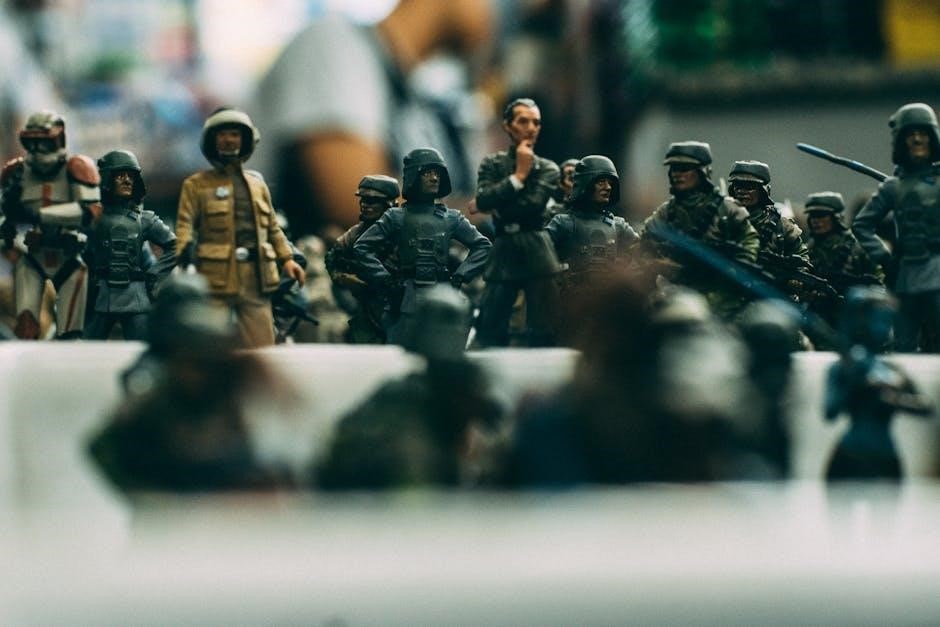
Components of the Army Combat Uniform (ACU)
The ACU includes a jacket, trousers, moisture-wicking T-shirt, and headgear like the Patrol Cap. Footwear options, such as Coyote Brown boots, complete the uniform for operational readiness.
The ACU jacket and trousers are designed for durability and functionality, made from moisture-wicking fabric to enhance comfort during physical activities. The jacket features a zippered front, Mandarin collar, and cargo pockets for storage. Trousers include cargo pockets, knee pad inserts, and an elastic waistband for a secure fit. Both components are made from the Operational Camouflage Pattern (OCP) material, ensuring optimal blend in various environments. Proper fit and wear are essential to maintain professionalism and readiness.
The moisture-wicking T-shirt is a lightweight, breathable base layer designed for comfort during physical training and field operations. Made from advanced fabric, it draws sweat away from the skin, reducing chafing and irritation. Available in Operational Camouflage Pattern (OCP) and sand color, it features a crew neck for versatility. Proper fit ensures optimal performance, making it an essential component of the Army Combat Uniform (ACU) and Operational Camouflage Pattern (OCP) setups. Soldiers are required to wear it tucked into their trousers for a neat appearance.
Headgear and footwear are critical components of Army uniforms, ensuring both functionality and adherence to regulations. The OCP patrol cap is standard for operational uniforms, while the AGSU features a garrison cap. Footwear varies by uniform: Coyote Brown boots are mandatory with OCP, and black oxfords accompany the AGSU. Proper fit and polish are essential for a sharp appearance. Soldiers must ensure their headgear and footwear are clean, well-maintained, and worn correctly to meet Army standards and present a professional image. These elements complete the uniform, emphasizing discipline and readiness.
Uniform Accessories
Uniform accessories, including badges, insignia, ribbons, and medals, enhance professionalism and identity. Proper placement and wear are crucial, guided by regulations and tools like the Wear It Right Army Uniform Tool.
Badges and Insignia
Badges and insignia are integral to Army uniforms, signifying achievements, qualifications, and service. Proper placement is critical, with unit award emblems positioned 1/8th inch above the right breast pocket. Subdued badges are authorized for combat uniforms, while dress uniforms require polished versions. Foreign badges are restricted on certain uniforms, ensuring adherence to regulations. These elements enhance identity and professionalism, reflecting a soldier’s dedication and accomplishments. Correct wear ensures uniformity and respect for tradition.
Ribbons and Medals
Ribbons and medals are worn to recognize service, achievements, and valor. They are arranged in a specific order on the uniform, with higher awards placed above others. Ribbons are centered on the chest, aligned with the bottom of the medal row. Medals are worn on formal uniforms like the ASU, while ribbons represent them on everyday attire. Proper alignment and spacing ensure a polished look. Updates in 2025 clarified placement guidelines, ensuring consistency across all uniforms. Always refer to official resources for precise instructions.
Name and Rank Tags
Name and rank tags are essential for identification and professionalism. They are worn on the uniform to display the soldier’s name and rank clearly. Name tags are typically placed on the right side of the chest, while rank insignia is centered on the left. Both must be official issue to ensure consistency. Updates in 2025 clarified that name tags are mandatory for all uniforms, except in specific operational scenarios. Proper alignment and secure fastening are required to maintain a sharp appearance. Always follow official guidelines for accurate placement.

Proper Placement of Insignia and Badges
Proper placement of insignia and badges ensures a professional appearance. Right breast pocket placement is for unit awards, while left side is for individual decorations. Sleeve insignia is centered 1/2 inch below the shoulder seam. Updates in 2025 clarified configurations for subdued badges, ensuring consistency across all uniforms. Always refer to official guidelines for precise measurements and alignment to maintain uniformity and adherence to regulations.
Right Breast Pocket Placement
The right breast pocket is reserved for unit award emblems and combat service badges. These items are positioned 1/8 inch above the pocket’s top edge, centered horizontally. Subdued badges are authorized in certain configurations, as updated in 2025 regulations. Proper alignment ensures a polished appearance, reflecting attention to detail. Soldiers should consult official guidelines or use tools like the Wear It Right Army Uniform Tool for precise measurements. Adhering to these standards maintains uniformity and professionalism across all ranks.
Left Breast Pocket Placement
The left breast pocket is designated for individual awards and decorations, such as ribbons, medals, and badges. These items are centered and aligned 1/8 inch above the pocket’s top edge. Subdued badges are permitted in specific configurations, as outlined in updated 2025 guidelines. Proper placement ensures a neat and professional appearance, showcasing a soldier’s achievements. Referencing official regulations or tools like the Wear It Right Army Uniform Tool helps maintain accuracy and compliance with current standards.
Sleeve Insignia Placement
Sleeve insignia, such as unit patches and rank, are placed on the left and right sleeves of the uniform. Unit patches are centered 1/2 inch below the top of the shoulder seam. Rank insignia, like chevrons, are positioned 1/2 inch above the cuff or braid. Subdued insignia configurations are authorized for operational uniforms. Proper alignment and spacing ensure a professional appearance. Updated 2025 guidelines clarify placement for both Class A and operational uniforms, ensuring consistency across all soldiers. Use the Wear It Right Army Uniform Tool for precise measurements and compliance.
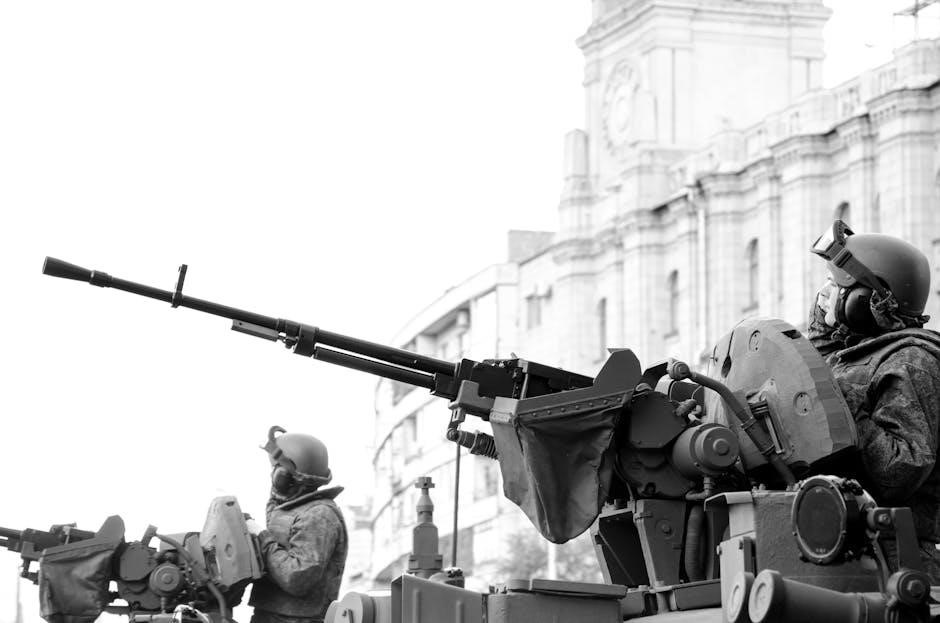
Uniform Grooming Standards
The Army issued new grooming directives in September 2025, emphasizing neatness and professionalism. Regulations cover hair length, facial hair, and nail care, ensuring a sharp appearance.
Hair Regulations
The Army’s updated grooming standards emphasize neatness and professionalism. Hair must be kept within specific length guidelines, avoiding extreme styles. Men’s hair should be neatly trimmed, with no visible sideburns below the ear. Women’s hair must be styled to stay above the collar, with no loose ends. All styles must be conservative and avoid distractions. These rules ensure uniformity and maintain the Army’s professional image, reflecting discipline and adherence to regulations. Proper hair grooming is essential for a sharp, military appearance.
Facial Hair and Shaving
The Army’s grooming standards require soldiers to maintain a clean, professional appearance. Facial hair is strictly regulated, with most soldiers required to be clean-shaven. Sideburns must be neatly trimmed and cannot extend below the earlobe. Beards are generally prohibited unless authorized for medical or religious reasons, requiring a waiver. Proper shaving ensures a polished look, aligning with the Army’s emphasis on discipline and uniformity. These standards apply to all soldiers, ensuring consistency and adherence to military traditions.
Nail and Hand Care
Soldiers must maintain clean, well-groomed nails and hands. Fingernails should be trimmed short, not extending beyond the fingertip, and kept clean. Nail polish is prohibited for men and must be subtle for women. Hands should be clean, with no dirt or grime visible. Proper hand care ensures a professional appearance, aligning with Army grooming standards. These practices contribute to overall discipline and readiness, reflecting the Army’s emphasis on personal hygiene and neatness in all aspects of uniform wear and daily duties.
Uniform Wear Regulations
Uniform wear regulations ensure soldiers present a professional image. Updates in 2025 clarify guidelines for AGSU and PT gear, reflecting modernized policies for military attire and grooming standards.
Class A and Class B Uniforms
Class A uniforms are the most formal, typically worn for ceremonies and official events, while Class B uniforms are less formal, suitable for daily duties. Both require precise grooming and proper insignia placement. The 2025 updates clarify wear guidelines, ensuring consistency across all ranks. Soldiers must adhere to these standards to maintain a professional appearance, reflecting the Army’s tradition and discipline. Proper wear of Class A and B uniforms demonstrates respect for the institution and contributes to unit cohesion. Attention to detail is crucial for a sharp, military appearance.
PT (Physical Training) Uniform
The PT uniform, also known as the Army Physical Fitness Uniform (APFU), is designed for physical training and fitness activities; It includes a moisture-wicking shirt and shorts, available in black and gold. The uniform must be worn correctly, with the Army logo centered on the shirt and no unauthorized modifications. Recent updates allow some soldiers to wear approved socks and reflective belts for safety. Proper wear ensures a professional appearance, even during physical training, maintaining the Army’s standards of discipline and readiness.
Special Occasion Uniforms
Special occasion uniforms are worn during formal events, ceremonies, and parades. The Army Service Uniform (ASU) and Army Green Service Uniform (AGSU) are commonly used for these purposes. Soldiers must ensure proper wear, including ribbons, medals, and insignia, to maintain a polished appearance. These uniforms reflect the Army’s heritage and professionalism, making them essential for representing the military at significant events. Adherence to specific guidelines ensures uniformity and respect for tradition during these occasions.
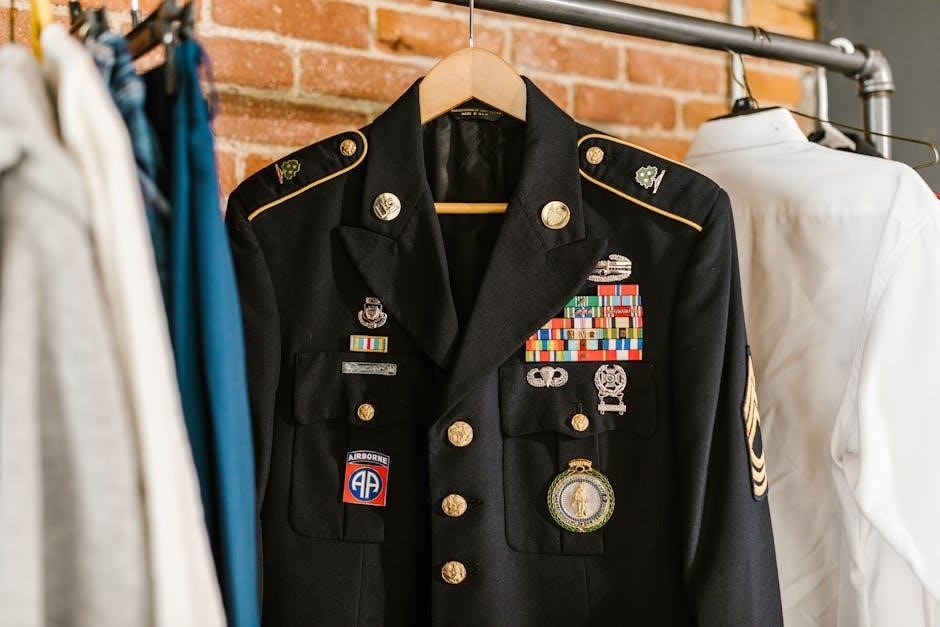
Recent Updates to Uniform Regulations
The U.S. Army issued new directives on September 15, 2025, tightening grooming and uniform policies. Updates include clarified wear guidelines for the AGSU and PT uniforms, effective immediately.
2025 Policy Changes
The U.S. Army introduced updated uniform policies on September 15, 2025, focusing on grooming and uniform standards. These changes include stricter regulations on personal appearance and uniform wear. The Army Green Service Uniform (AGSU) and Physical Training (PT) gear saw specific updates, with clarified guidelines for proper wear. Additionally, the Army emphasized the use of the “Wear It Right” tool for accurate uniform setup. These updates aim to enhance discipline, safety, and professionalism across all ranks, ensuring soldiers present a sharp and consistent appearance.
Clarifications on Uniform Wear
The Army issued updated guidelines for uniform wear, focusing on the Army Green Service Uniform (AGSU) and PT gear. These clarifications provide specific instructions for soldiers, ensuring proper wear and appearance. The updates address common questions and misunderstandings, offering clear direction on uniform components and accessories. Additionally, the Army emphasized the use of the “Wear It Right” tool to help soldiers achieve accurate and regulation-compliant uniform setups. These clarifications aim to promote consistency and professionalism across all ranks and units.

Uniform Setup Tools and Resources
The Army offers tools like the “Wear It Right” uniform guide and online tutorials to help soldiers achieve accurate and regulation-compliant uniform setups effortlessly.
Wear It Right Army Uniform Tool
The “Wear It Right” Army Uniform Tool is a comprehensive guide designed to help soldiers achieve perfect uniform setups. It provides detailed instructions, visuals, and tips for every uniform type. Whether you’re new to uniforms or need a refresher, this tool ensures compliance with regulations. Features include a promo code (YT10) for discounts and step-by-step guides for ASU, AGSU, OCP, and ACU. It’s an essential resource for maintaining a sharp, professional appearance and understanding uniform standards effortlessly.
Online Guides and Tutorials
Online guides and tutorials offer detailed step-by-step instructions for setting up Army uniforms. Platforms like YouTube and official Army websites provide videos and written guides. These resources cover uniform types, insignia placement, and grooming standards. Tutorials often include visuals and demonstrations, making complex regulations easier to understand. Soldiers can access these tools anytime, ensuring they meet current standards. Additionally, official Army resources are regularly updated to reflect policy changes, such as the 2025 grooming and uniform wear updates, helping soldiers stay informed and compliant.
The Army Uniform Setup Guide ensures soldiers present a professional image, adhering to updated 2025 regulations. Proper grooming and uniform setup enhance discipline, safety, and esprit de corps.
Final Tips for a Sharp Appearance
Ensure your uniform fits well and is clean. Pay attention to proper insignia placement and grooming standards. Use tools like the Wear It Right Army Uniform Tool for guidance. Regularly inspect your uniform for wear and tear. A sharp appearance reflects professionalism and discipline, essential for military service. Stay updated on 2025 uniform regulations to maintain compliance. Remember, a well-maintained uniform not only honors tradition but also enhances safety and readiness in the field.
Importance of Adhering to Regulations
Adhering to Army uniform regulations ensures consistency, discipline, and professionalism. Proper attire reflects respect for tradition and authority, fostering unit cohesion. It also ensures safety in operational environments, as uniforms are designed for functionality. Following guidelines demonstrates commitment to military standards and accountability. Neglecting regulations can lead to disciplinary action and undermine team integrity. Stay updated on 2025 policy changes to maintain compliance and uphold the Army’s legacy of excellence. A well-presented uniform is a symbol of pride and readiness.